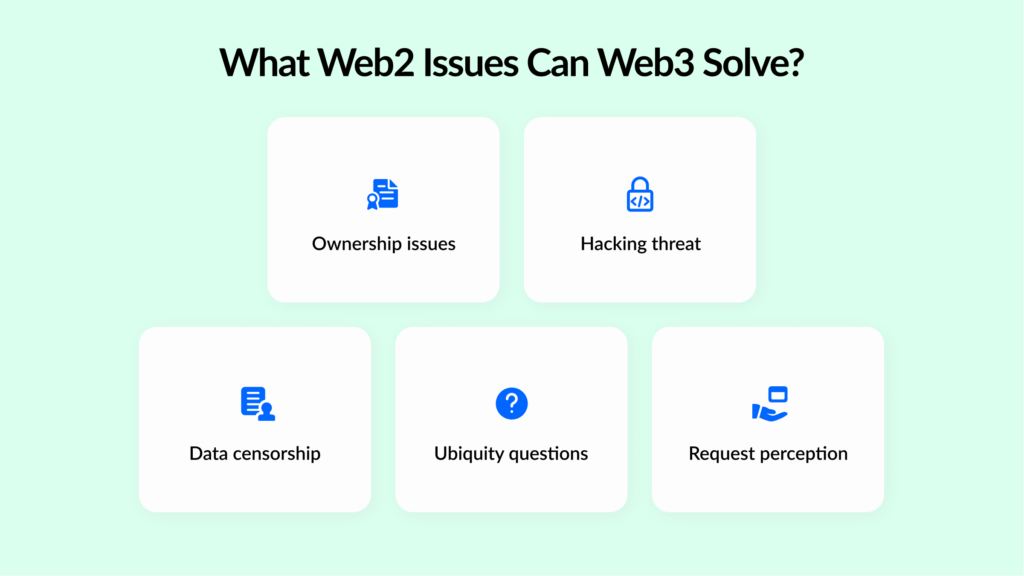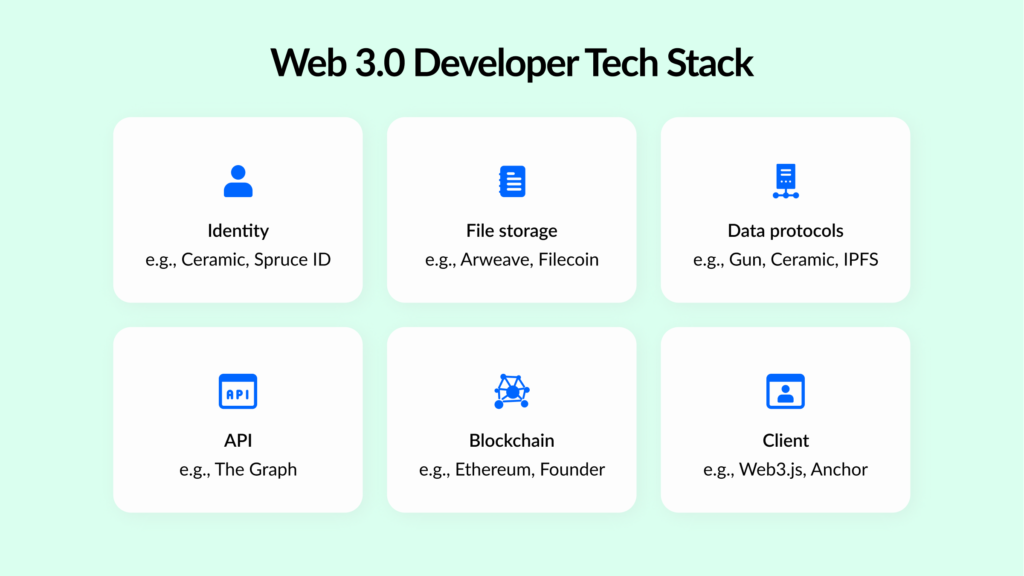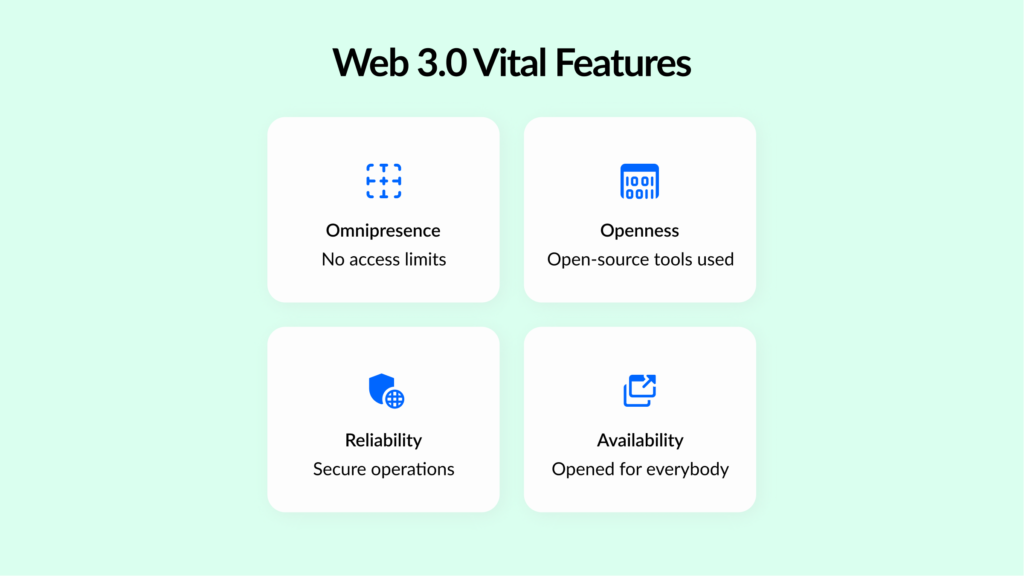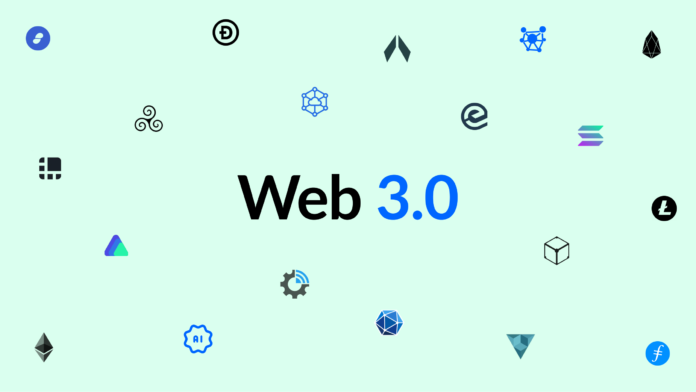As part of modern Internet development, we can see the world’s rising quantity of claims that in the near future, we will experience the transition from Web 2.0 to Web 3.0.
In this article, we’ll talk about the development of the Internet and web technology, specifically about Web 2.0 and Web 3.0. Let’s find out what is the main essence of these versions of the Internet, their features, and new technologies.
Web 2.0 and Web 3.0: Principles and Concepts
In reality, we still don’t have a straightforward and entirely confessed notion of the Web- it still isn’t outlined. Yet, we still are able to determine a range of interpretations.
To illustrate, a prevailing number of users mix the “web” with WWW (World Wide Web), which relates to the term of the Internet, which in fact, can’t be considered as a considerable mistake. However, we should keep in mind that the “Internet” is a much more pervasive notion, so the web is more likely to be considered as its element.
Taking a range of web generations into account, it would be more appropriate to assign the term with the following definition: Web is a kit of instruments, solutions, and approaches to interconnection and communication among users within the Internet space.

Web 2.0 is a paradigm shift in the use of the Internet. Over the past 15-20 years, Web 1.0 has been entirely substituted by Web 2.0 with the dynamics of social media and user-created content. Web 2.0 enables a vast number of individuals globally to consume user-generated content practically in an instant; this unexampled opportunity has resulted in an outbreak of user-produced content in further years.
One of the key principles of Web 2.0 is that Internet platforms were now designed with the engagement of the users directly, where each enthusiast could upload more data.
The transmission to Web 2.0 had majorly become real through the enhancement of technology – worldwide Internet availability with a substantial rapid growth, the creation of browsers, as well as the delivery of drastically changed services – social networks, blogs, podcasts, and video hosting.
Web 3.0, in turn, refers to the upcoming iteration or phase in the upgrading and development of the Web / Internet and has the capacity to be equally renewed and comprise as huge a paradigm shift as Web 2.0. Web 3.0 is designed on the fundamental concepts of decentralization, transparency, and enhanced user leverage. Here are the key principles of Web 3.0:
- Decentralization. Data won’t be kept on a standalone server anymore- it will be distributed among users. The essential computations will transfer from data hubs to users’ desktops, mobile devices, and smart gadgets. Currently, the IT market is ready to deliver new technologies to implement this, but there is no consensus on which one will be at the heart of the “new Internet.”
- Artificial Intelligence and Machine Learning. Intelligent algorithms will still remain potent for the Web and continue to accompany users in looking for content engaging for them. Some scientists emphasize that in further years AI can be applied to detect custom comments on marketplaces. This capability will help deliver more clear and straightforward services;
- Transparency. The prevailing portion of software will be open-source, which will enable an in-depth comprehension of instruments’ design details as well as their interaction with the audience;
- Bottom-up design and organization. The moderate teams of software engineers developing and managing the product will be eliminated; it will be created in an open and transparent way, resulting in maximum engagement and involvement.
- Independence. Censorship within the Internet is projected to be rejected, also each enthusiast will be allowed to upload any desired content; the role of governance position will be assumed by the audience, not by enterprises;
- Omnipresence. Specialists define that in the phase of Web 3.0, the Internet will be virtually in any location, and the providers will be IoT-based tools and “smart” devices;
- Semantic web. The algorithm still doesn’t perceive natural language requests well and still tends to make failures. To enhance this process, it is predicted to apply the solution of the semantic web, when you can extract the data from the web of the form “subject – a type of relationship – another subject” and build logical connections directly on this data.

Considering the key feature of Web 3.0, we can observe the one booming technology, which is blockchain. Web 3.0 assumes that practically all of the utter data, whether it is banking details or ordinary amusing content will be kept decentralized. This fact provides not only for its safety but also solidity from censorship.
Blockchain has become the practical illustration of decentralization in the financial system. Many users have already gotten acquainted with cryptocurrencies and the key concept of such solutions. All financial operations and wallet accounts are stored in a single chain, the blockchain. It is challenging to modify the transaction details in this blockchain for one reason- it is located on the hardware of each engaged party in the network. It turns out that there is no major hub or governing body that can arbitrarily modify user accounts.

Web 3.0: Key Capabilities
Considering the upcoming modifications of Web 3.0, let’s observe the opportunities it provides:

Web 3.0 is able to ensure much more solid value to users, going far beyond the social networking, streaming, and online shopping that make up the majority of Web 2.0 solutions leveraged by clients. Opportunities of such solutions as the semantic web, AI, and ML that reinforce Web 3.0 can significantly raise the range of solutions in innovative fields and substantially enhance user interactions.
Core Web 3.0 features such as decentralization and unannounced solutions will also ensure users much more management capabilities for their personal details. This can set bound data retrieval methods- which implies the information assembled from Internet users with no agreement or reimbursement- and restrain the network impacts that have allowed technology titans to get closer-monopolists through the use of advertising and marketing exploitation techniques.
Summarize
Web 2.0, the current version of the Internet with which we are all familiar, has a lot of differences from Web 3.0, which is the next phase of the Internet. We would like to point out that for business, the lack of monopoly will be beneficial and extremely beneficial, which will contribute to the transition of market management of various industries into the hands of users, not organizations.
Yuliya Melnik is a technical writer at Cleveroad. It is a web and mobile app development company in Ukraine. She is passionate about innovative technologies that make the world a better place and loves creating content that evokes vivid emotions.















